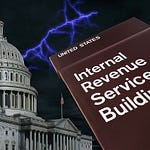For years, the Intergovernmental Panel on Climate Change (IPCC) has been the global megaphone insisting that humans, specifically the carbon dioxide (CO₂) we pump out from cars, factories, and power plants, are the main reason the Earth’s temperature is rising. They say our CO₂ has damaged the planet’s energy balance, and they back this up with computer models and adjusted temperature records. But when you take a step back, look at the raw data, and listen to what some independent scientists are saying, the IPCC’s big claims start to look more than just a bit shaky.
This isn’t about denying climate change; the Earth’s climate changes constantly and has been in constant flux since the beginning of time. It’s about questioning whether the IPCC has been too quick to blame humans while ignoring bigger natural forces and extorting hundreds of billions in research funding from countries around the world.
• SEGMENT 2: Why Do Federal Judges
Champion Violent Gang Members Over US Citizens?
It should be noted here that, extrapolating back to the 1970s, when climate funding began gaining traction (e.g., post-Charney Report in 1979), total US and international public funding for climate science and green initiatives likely ranges into the hundreds of billions, potentially nearing a trillion dollars when adjusted for inflation and including diverse programs.
The IPCC, which is overseen by the United Nations Environment Programme and the World Meteorological Organization, insists that since the Industrial Revolution began around 1750, our CO₂ emissions have thrown the climate out of whack. They rely on complex computer models and tweaked temperature records to make their case, pushing the idea that we need to cut emissions fast or face disaster.
But when you check the unadjusted facts—data that hasn’t been manipulated—and hear from researchers who aren’t on the IPCC bandwagon, things don’t add up so neatly.
Take CO₂ itself. The IPCC acts like our emissions have an enormous impact, but here’s the reality: humans release about 10 billion tons of carbon each year as CO₂. Compare that to nature, which moves around 230 billion tons annually—80 billion from oceans and 140 billion from plants and soil. That means our share is just 4% of the total. Imagine a big potluck where nature brings 96 dishes and we show up with a tiny side salad—does that sound like we’re the ones steering the meal?
Scientists like Demetris Koutsoyiannis have dug into this and found that our CO₂ doesn’t even stick around long enough to cause much trouble. They use something called isotopic evidence—like a fingerprint for carbon—to show that the air’s CO₂ mix has barely changed over 200 years. Even with a big jump in CO₂ since 1980, the shift is tiny, much less than you’d expect if our emissions were significant in any way. And during the 2020 COVID lockdowns, when we cut emissions by 7% (0.7 billion tons), the CO₂ levels at Mauna Loa didn’t budge. If our CO₂ was such a game-changer, wouldn’t we have noticed?
The IPCC says our CO₂ hangs around for 120 years or more, building up like a slow disaster. But Koutsoyiannis and others, like Hermann Harde, say it’s more like 3.5 to 4 years before nature sweeps it away. That’s a huge gap—and it suggests the IPCC is exaggerating our impact.
The IPCC leans heavily on computer models—called GCMs—from projects labeled CMIP3, CMIP5, and CMIP6. These are supposed to predict the future, but they keep getting it wrong. Researchers like Ross McKitrick and John Christy found that most of these models overestimate how much the lower atmosphere (the troposphere) is warming. The models say it should heat up by 0.15 to 0.5°C every decade, but satellite data shows it’s only 0.13°C—a small but telling miss. When you compare the two, the models barely line up, like a weather app that keeps predicting rain on sunny days.
It’s not just the air. The models predicted Arctic sea ice would shrink by 20-50% since 2007, but real measurements show it’s been steady at about 4.4 million square kilometers. And old rural temperature records from the US, untouched by adjustments, sit steady at 12.2°C from the 1930s to now, while the latest models guess 13.3 to 14.4°C, off by a full degree or two.
Here’s something else: scientists like Ole Humlum and Murray Salby noticed that temperatures often rise before CO₂ levels go up, by about 6 to 12 months. That’s like saying the oven heats up before you turn it on. It could mean warming is pushing CO₂ out of oceans and soil—like fizz popping out of a warm soda—not CO₂ cranking up the heat. The IPCC’s models aren’t built to handle that twist, and it shows.
If our CO₂ isn’t the main driver, what is? How about the most logical source: the sun?
The IPCC brushes off changes in sunlight, sticking to one estimate that says solar energy (Total Solar Irradiance, or TSI) has barely ticked up since 1850—by just 0.05 watts per square meter. But there are 27 other estimates out there, and some show bigger swings—0.5 to 1 watt per square meter.
Researchers like Willie Soon say these bigger changes match up well with actual warming, showing strong links (up to 0.9 or even 0.95) with temperature records since 1850, way better than CO₂’s weak 0.3 to 0.5 connection. That suggests the sun’s heat—and how it affects clouds—might explain a lot, maybe even all, of the warming we’ve seen.
So why does the IPCC stick to its lowball estimate? It’s like blaming a dim lamp for a bright room while the sun’s blazing outside.
Then there’s the temperature data itself. The IPCC uses records from places like NOAA and NASA, but those numbers get “adjusted.” Studies by Ronan Connolly and Willie Soon show how these tweaks downplay hot spells in the 1930s (dropping from 12.8°C to 11.7°C) and bump up recent years (from 12.2°C to 12.8°C). A small rural rise of 0.2 to 0.5°C gets turned into a bigger 0.8 to 1.1°C global jump.
Raw data from modern US stations shows little change (+0.4°C, flat), and older rural records hold steady at 12.2°C—yet the adjusted versions magically match the models. Even the famous “hockey stick” graph, which flattens out past warm periods, looks more like a storytelling trick than solid science.
So what’s the takeaway? The IPCC’s been hammering the idea that our CO₂—human-created CO₂—is the climate’s big bad wolf, but the evidence—raw data, carbon cycles, sunlight, and shaky models—points to nature still being in charge.
Our emissions are a small piece of the puzzle, not the whole picture. Their models don’t predict well, their sun estimates are too timid, and their data tweaks raise eyebrows.
It’s time to stop buying their story hook, line, and sinker and start asking what’s really going on. The sun, the oceans, and a messy mix of natural shifts might hold the real answers, not just a CO₂ villain we’ve been told to fear.
In fact, CO₂ is essential for plant growth because it serves as a key raw material in photosynthesis, the process by which plants convert sunlight into energy. Without sufficient CO₂, plants cannot efficiently produce the energy needed for growth, development, and reproduction, making it a critical component of their life cycle and overall ecosystem health.
The IPCC’s had its say, and that say has involved trillions of dollars both in special interest profit and economic regulations, and nothing has changed at the hands of man. So, let’s give nature a fair shot and rethink this issue from scratch.
Then, when we return, our segment on America’s Third Watch, broadcast nationally from our flagship station WGUL AM930 & FM93.7 in Tampa, Florida.
Why Do Federal Judges Champion
Violent Gang Members Over US Citizens?
In recent months, a troubling pattern has emerged within the US federal judiciary, particularly among lower court judges, that raises serious questions about the integrity of our legal system.
Across the country, US District Court judges have issued rulings that obstruct the removal of known violent gang members from Central and South America, thwarting efforts by the Trump administration to protect American citizens from the escalating threat of transnational crime.
At the heart of this controversy lies a glaring case: Chief Judge James "Jeb" Boasberg of the US District Court for the District of Columbia, whose personal ties to immigration advocacy reveal a potential conflict of interest that exemplifies the broader dysfunction within the federal bench.
Why, one must ask, are these judges so determined to shield dangerous criminals from deportation? The answer lies in a toxic blend of ideological bias, personal entanglements, and an alarming disconnect from the realities faced by everyday Americans.
Let’s begin with the specifics of Judge Boasberg’s case, which has become a lightning rod for criticism.
In March 2025, Boasberg issued a temporary restraining order blocking the Trump administration’s use of the Alien Enemies Act of 1798 to deport members of the Venezuelan gang Tren de Aragua. This gang, notorious for its brutality and involvement in human trafficking, drug smuggling, and violent crime, has infiltrated American cities, exploiting lax border policies established during the open-border years of the Obama and Biden administrations. The Trump administration’s invocation of the centuries-old law was a bold move to expedite the removal of these threats without the bureaucratic delays of standard immigration proceedings. Yet Boasberg, in a decision dripping with sanctimonious and elitist legalese, halted the deportations, arguing that the accused gang members deserved individualized hearings—a stance that critics argue prioritizes the rights of foreign criminals over the safety of US citizens.
What makes Boasberg’s ruling particularly galling is the revelation of his family’s deep ties to immigration advocacy. His daughter, Katharine Boasberg, works for Partners for Justice, a 501(c)(3) organization that provides legal assistance to "justice-involved individuals," including undocumented immigrants and, notably, those accused of gang affiliations. Meanwhile, his wife, Elizabeth "Betsy" Boasberg, has a history of involvement with government-funded NGOs, as does his sister, Margaret Boasberg, some of which receive taxpayer dollars to advance left-wing policies.
These connections—and especially his relationship with his daughter—raise a stark question: How can a judge rule impartially on a case involving the deportation of violent gang members when his immediate family member is professionally invested in outcomes that favor immigrant retention? The stench of conflict of interest, as in the issue of Juan Merchan presiding over Trump’s trial, is overwhelming, yet Boasberg did not recuse himself, nor did he—like Merchan—disclose these ties upfront, leaving the public to wonder whether justice was truly blind in his courtroom.
This isn’t just about one judge, however. Boasberg’s actions reflect a broader trend among federal district judges, many of whom seem to view their role not as enforcers of the law but as arbiters of a progressive moral agenda. These judges—most often appointed by Democrat administrations—appear to harbor a reflexive sympathy for immigrants, regardless of their criminal status, that overrides national security concerns.
The Tren de Aragua case is not an isolated incident. Across the country, federal judges have issued injunctions against immigration enforcement actions, from sanctuary city policies to ICE raids, often cloaking their decisions in lofty rhetoric about due process and human rights. But when the individuals in question are tied to violent gangs like MS-13 or Tren de Aragua, whose members have been linked to murders, extortion, human trafficking, and terror in American communities, this judicial posturing starts to look less like principle and more like complicity.
Why are these judges so eager to obstruct the removal of such clear threats? One probability is ideological capture. The federal judiciary, particularly at the district level, is stocked with jurists who came of age in an era of liberal activism, where the narrative of the "oppressed migrant" became sacrosanct. For these judges, deporting a gang member isn’t just a legal act—it’s a moral failing, a betrayal of America’s supposed identity as a nation of immigrants.
Never mind that the immigrants of Ellis Island weren’t carrying AK-47s or trafficking humans across borders. This worldview, marinated in elite law schools and neo-Marxist progressive legal circles, blinds them to the havoc wrought by groups like Tren de Aragua, whose presence in the US is a direct consequence of unchecked illegal immigration and the Obama-Biden open-borders policy.
Another factor is the cozy relationship between the judiciary and the nonprofit industrial complex.
Government-funded NGOs, like those tied to Boasberg’s family, wield enormous influence over immigration policy, often acting as the ground troops for open-border advocates. These organizations rely on a steady stream of clients—migrants, documented or not—to justify their funding and existence. Deporting violent gang members disrupts this ecosystem, threatening the livelihoods of the activists, lawyers, and administrators who profit from it, until recently, those profits emanating from USAID.
When judges like Boasberg, with personal stakes in this world, rule against deportation, it’s hard not to see a quid pro quo at play: protect the system, and the system protects you.
The consequences of this judicial overreach are dire. In the Tren de Aragua case, over 200 alleged gang members were deported to El Salvador’s mega-prisons after Boasberg’s initial order was rightly defied—a move that sparked outrage from the administration’s critics but relief from communities terrorized by these criminals.
Yet Boasberg’s insistence on “due process,” echoed by other judges in similar cases, risks tying the government’s hands in future operations. If every deportation requires a protracted legal battle, the message to gangs is clear: come to America, commit your crimes, and trust the courts to shield you. Meanwhile, American taxpayers foot the bill for endless hearings, while families mourn loved ones lost to the butchery of gang violence.
Critics of the judiciary argue that this is a feature, not a bug, of a system designed to thwart executive authority. The Trump administration’s aggressive use of the Alien Enemies Act was undoubtedly provocative, stretching a wartime statute to address a modern crisis. But the law’s text allows for such flexibility, granting the president broad powers to remove "alien enemies" during threats of invasion—a term that fits the coordinated incursion of criminal organizations across our borders. Federal judges, however, seem intent on rewriting the law through their rulings, asserting a supremacy that undermines both the Executive Branch and the will of the electorate that returned Trump to power on a promise to secure the nation.
Perhaps Congress needs to create a federal court, limited in its lifespan and singular in scope, to hear these specific cases; to hear cases specific to the issue of mass deportations and the expulsion of violent criminal illegal aliens and those who have arrived illegally through our borders during the Obama and Biden years. They have the power to create lower courts. Why not use it and dictate the terms?
The Boasberg saga underscores a deeper rot in the lower courts: a lack of accountability. Unlike Supreme Court justices, whose rulings are scrutinized by a national audience, district judges operate in relative obscurity, wielding immense power with little oversight. Boasberg’s failure to recuse himself, despite his family’s entanglements, is a glaring ethical lapse that would sink a lesser official. Yet the judiciary’s self-policing mechanisms are notoriously weak, leaving the public with few recourses beyond calls for impeachment—a drastic step that, as Chief Justice John Roberts recently noted, is unlikely to succeed.
So why do these judges persist in obstructing the removal of violent gang members? It’s a mix of ideology, self-interest, and an arrogance born of unassailable tenure. They see themselves not as servants of the law but as guardians of a pseudo-utopian vision, one where borders are irrelevant and criminals are just misunderstood victims.
For Judge Boasberg, the personal stakes amplify this tendency, casting a shadow over his rulings that no amount of legal jargon can dispel. Until the federal judiciary is reined in—whether through legislative reform, public pressure, or a reckoning at the ballot box—the safety of Americans will remain hostage to the whims of unelected jurists more loyal to their biases than to the people they swore to serve.
The question isn’t just why they’re doing this—it’s how long we’ll let them get away with it.


















